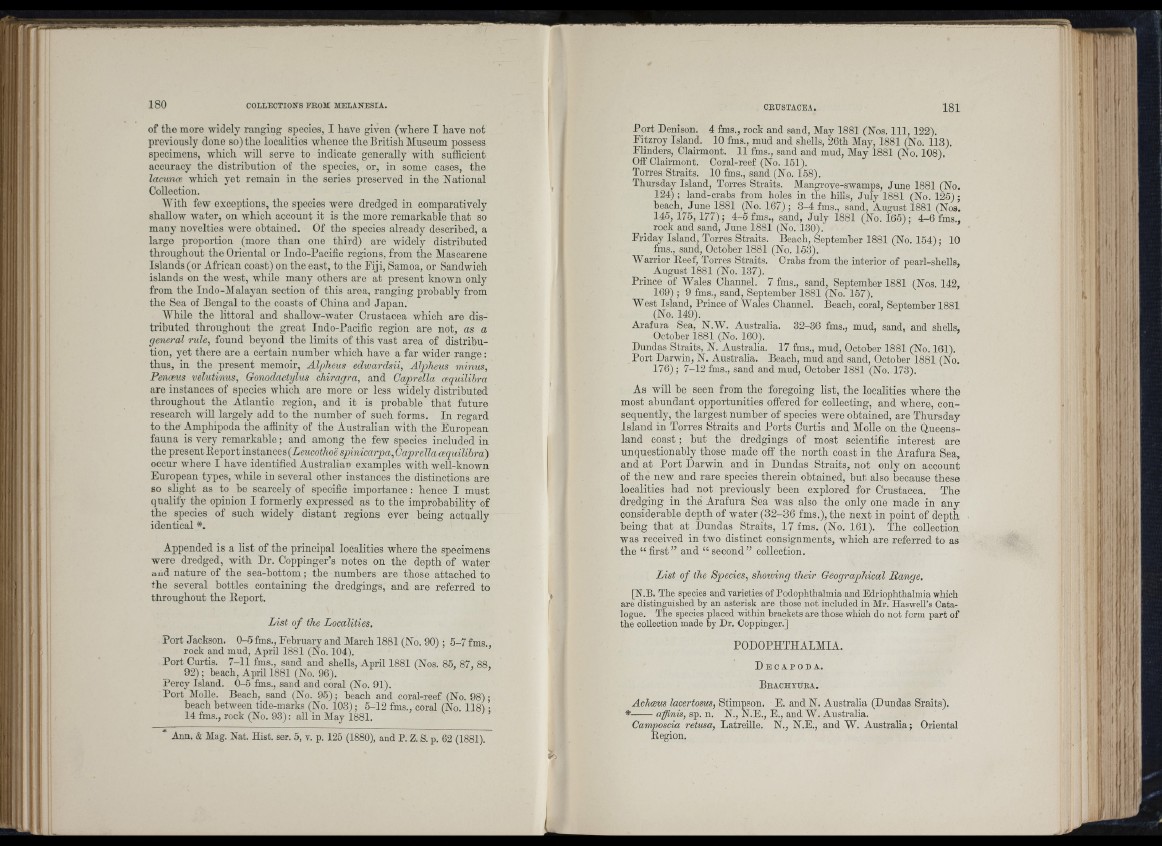
Î5 ? ,
180 COLLECTIONS FEOM MELANESIA.
of the more widely ranging species, I have given (where I have not
previously done so) the localities whence tho British Museum possess
specimens, which will serve to indicate generally with sufficient
accuracy the distribution of the species, or, in some cases, the
lacunce which yet remain in the series preserved in the National
Collection.
AYith few exceptions, the species were dredged in comparatively
shallow water, on which account it is the more remarkable th a t so
many novelties were obtained. Of the species already described, a
large proportion (more than one third) are widely distributed
throughout the Oriental or Indo-Pacific regions, from the Mascarene
Islands (or African coast) on the east, to the Fiji, Samoa, or Sandwich
islands on the west, while many others are at present known only
from the Indo-Malayan section of this area, ranging probably from
the Sea of Bengal to the coasts of China and Japan.
AVhile the littoral and shallow-water Crustacea which are distributed
throughout the great Indo-Pacific region are not, as a
general rule, found beyond the limits of this vast area of distribution,
yet there are a certain number which have a far wider ran g e ;
thus, in the present memoir, Alpheus edwardsii, Alpheus minus,
Pencnis velutinus, Gonodactylus chiragra, and Caprella crquilihra
are instances of species which are more or less widely distributed
throughout the Atlantic region, and it is probable th at future
research wiU largely add to the number of such forms. In regard
to the Amphipoda the affinity of the Australian with the European
fauna is very remarkable; and among the few species included in
the present Report instances (Leucothoe spinicarpa, Caprella cequilibra)
occur where I have identified Australian examples with well-known
European types, while in several other instances the distinctions are
so slight as to be scarcely of specific importance: hence I must
qualify the opinion I formerly expressed as to the improbability of
the species of such widely distant regions ever being actually
identical *.
Appended is a list of the principal localities where the specimens
were dredged, with Dr. Coppinger’s notes on the depth of water
aud nature of the sea-hottom; the numbers are those attached to
the several bottles containing the dredgings, and are referred to
throughout the Report.
List o f the Localities.
Port Jackson. 0 -5fms., February and March 1881 (No. 90): 5-7 fms.,
rock and mud, April 1881 (No. 104).
Port Curtis. 7-11 fms., sand and shells, April 1881 (Nos. 85, 87, 88.
92); beach, April 1881 (No. 96). ’ ’ >
Hercy Island. 0-5 fms., sand and coral (No. 91).
Port Molle. Beach, sand (No. 95); beach and coral-reef (No. 98);
beach between tide-marks (No. 103); 5-12 fms., coral (No. 118) ■
14 fms., rock (No. 93): all in May 1881. ' ’
Ann. & Mag. Nat. Hist. ser. 5, v. p. 125 (1880), and P. Z. S. p. 62 (1881).
\
CETISTACEA. 181
Port Denison. 4 fms,, rock and sand, May 1881 (Nos. I l l , 122).
Fitzroy Island. 10 fms., mud and shells, 26th May, 1881 (No. 113).
Flinders, Clairmont. 11 fms., sand and mud. May 1881 (No. 108).
Ofi'Clairmont. Coral-reef (No. 151).
Torres Straits. 10 fms., sand (No. 158).
Thursday Island, Torres Straits. Mangrove-swamps, June 1881 (No.
124) ; land-crahs from holes in the hills, July 1881 (No. 125) ;
beach, June 1881 (No. 167); 3-4 fms,, sand, August 1881 (Nos.
146, 175, 177) ; 4-6 fms., sand, July 1881 (No. 165) ; 4-6 fms.,
rock and sand, June 1881 (No. 130).'
Friday Island, Torres Straits. Beach, September 1881 (No. 154) ; 10
fms., sand, October 1881 (No. 163).
Warrior Reef, Torres Straits. Crabs from the interior of pearl-shells,
August 1881 (No. 137).
Prince of Wales Channel. 7 fms., sand, September 1881 (Nos. 142,
169) ; 9 fms., sand, September 1881 (No. 157).
West Island, Prince of Wales Channel. Beach, coral, September 1881
(No. 149). ^
Arafura Sea, N.W. Australia. 32-36 fms., mud, sand, and shells,
October 1881 (No. 160). ’
Dundas Straits, N. Australia. 17 fms., mud, October 1881 (No. 161).
Port Darwin, N. Australia. Beach, mud and sand, October 1881 (No.
176); 7-12 fms., sand and mud, October 1881 (No. 173).
As will be seen from the foregoing list, the localities where the
most abundant opportunities offered for collecting, and where, consequently,
the largest number of species were obtained, are Thursday
Island in Torres Straits and Ports Curtis and Molle on the Queensland
coast ; but the dredgings of most scientific interest are
unquestionably those made off the north coast in the Arafura Sea,
and at Port Darwin and in Dundas Straits, not only on account
of the new and rare species therein obtained, hut also because these
localities had not previously been explored for Crustacea. The
dredging in the Arafura Sea was also the only one made in any
considerable depth of water (32-36 fms.), the next in point of depth
being th at at Dundas Straits, 17 fms. (No. 161). The collection
was received in two distinct consignments, which are referred to as
the “ first ” and “ second ” collection.
List o f the Species, showing their Geographical Range.
[N.B. The species and varieties of Podophthalmia and Edriophthalmia which
are distinguished by an asterisk are those not included in Mr. Haswell’s Catalogue.
The species placed within brackets are those which do not form part of
the collection made by Dr. Coppinger.]
PODOPHTHALMIA.
D e c a p o d a .
Brachyura.
Achæus ïacertosus, Stimpson. E. and N. Australia (Dundas Sraits).
* affinis, sp. n. N., N.E., E., and W. Australia.
Camposcia retusa, Latreille. N., N.E., and W. Australia; Oriental
Region.
Ï i:
,i; : q
IMb;
'I
ii h.
■ihif;
n '
'i, t |i i
(I■I Î
n , .